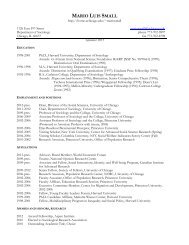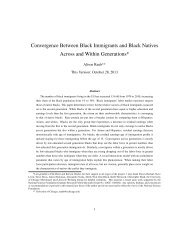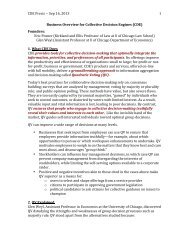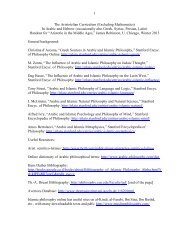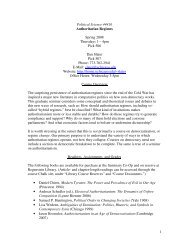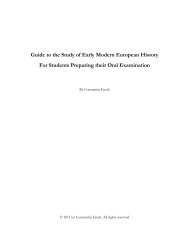Job Market Paper - Personal Web Pages - University of Chicago
Job Market Paper - Personal Web Pages - University of Chicago
Job Market Paper - Personal Web Pages - University of Chicago
You also want an ePaper? Increase the reach of your titles
YUMPU automatically turns print PDFs into web optimized ePapers that Google loves.
Kim: Endogenous Choice <strong>of</strong> a Mediator<br />
incentive constraint for the weak type is binding in a bargaining process, which implies that the<br />
strong type <strong>of</strong> a player begins to act according to virtual preferences which exaggerate the difference<br />
from the weak type that he needs to distinguish himself from.<br />
For example, when ¯p(s) = 0.4, mediator µ 1,¯z(0.4) = µ 1,0.1429 is the unique neutral bargaining<br />
solution that gives the interim incentive efficient allocations such that<br />
U i (µ 1,0.1429 |s) = 1.3714, U i (µ 1,0.1429 |w) = 2.4, ∀i.<br />
The conditions in Theorem (Myerson, 1984b) are satisfied for all ε by λ, α, and β such that<br />
λ i (s) ≥ 0.8829, λ i (w) = 1 − λ i (s),<br />
α i (w|s) = 0, α i (s|w) = 4 7 λ i(s), β i (s) = β i (w) = 0, ∀i.<br />
That is, the weak type jeopardizes the strong type, because the only problematical incentive constraint<br />
is that the weak type <strong>of</strong> any player should not have any incentive to claim that her type is<br />
strong if it is actually weak. Therefore, the strong type’s virtual utility is constructed as a positive<br />
multiple <strong>of</strong> his actual utility minus a positive multiple <strong>of</strong> the utility pay<strong>of</strong>f for the other type that<br />
jeopardizes the strong type; and the weak type’s virtual utility is a positive multiple <strong>of</strong> her actual<br />
utility.<br />
Using the parameters λ i (s) = 0.9, λ i (w) = 0.1, α i (s|w) = 0.5143, α i (w|s) = 0, and β i (s) =<br />
β i (w) = 0, the virtual utility functions are v i (d 0 , t, λ, α, β) = 0 for all i and all t (because u i (d 0 , t) = 0<br />
for all i and all t), and for all i:<br />
v i (d 1 , (s, t −i ), λ, α, β) = (0.9 · u i (d 1 , (s, t −i )) − 0.5143 · u i (d, (w, t −i ))) /(0.4),<br />
v i (d 1 , (w, t −i ), λ, α, β) =(0.1 + 0.5143)u i (d, (w, t −i ))/(0.6).<br />
That is, the virtual utility functions are as follows:<br />
Table 3: The Virtual Utilities when ¯p(s) = 0.4 and λ i (s) = 0.9<br />
t (s, s) (s, w) (w, s) (w, w)<br />
d = d 0 0, 0 0, 0 0, 0 0, 0<br />
d = d 1 0, 0 -7.4, 7.17 7.17, -7.4 4.1, 4.1<br />
If the players made interpersonal-equity comparisons in terms <strong>of</strong> virtual utility, then each type<br />
t i could justly demand half <strong>of</strong> the expected virtual utility that t i contributes by cooperating.<br />
40



